Namibia isn’t known for safari. This is Africa’s natural art gallery, a country of superlative landscapes and breathtaking silence.
Most people don’t even think a Namibia safari is possible. How can wildlife thrive in the desert? Why visit Namibia when Botswana and South Africa are next door?
Yet desert-adapted elephants make epic journeys across the sand. Rhinos gather around salt pans. Black-maned lions survey their dusty kingdoms. Gemsbok are everywhere, their majestic horns a symbol of Namibia.
A safari in Namibia can be as good as a safari anywhere else in Africa. It’s just a little different and you don’t have the same multitude of destinations.
This article guides first-time visitors through Namibia’s best safari destinations. It covers when to go, what to do, how to reduce costs, and how to make the most from the experience.
5 Compelling Reasons to Visit Namibia For Safari
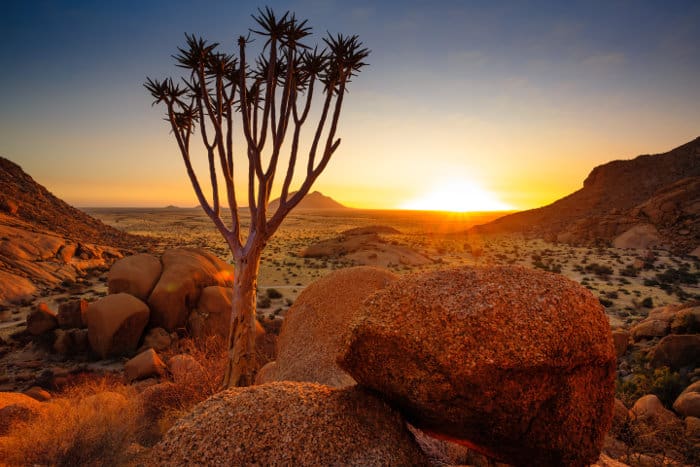
1. Africa’s natural art gallery
Namibia requires time. It’s one of the world’s most sparsely populated countries and it’s difficult getting around. There’s virtually nothing other than wilderness. Even a town that’s signposted for 500 kilometres passes by in the blink of an eye.
Most of the land is inhospitable. Western Namibia is covered by the world’s greatest sand dunes, a barrier too inpenetrable for even the rampaging colonialists.
Eastern Namibia is dominated by the Kalahari Desert, barren plains that bake beneath the sun. Scattered through these deserts are some of Africa’s most surreal sights.
The Fish River Canyon, stark and evocative as it cuts a path through Africa’s crust. It’s the world’s second largest canyon and you can read our guide here.
Then the Namib Desert, where Sossusvlei and Deadvlei are just the famous attractions in a landscape of kaleidoscopic dunes. Read our complete Namib Desert guide here.
Damaraland is all strange rocks and massive mountains, an ethereal assortment of shapes and silence.
The desert has even taken over towns. Luderitz and Kolmanskop are a poignant reminder of nature’s power, where old wooden houses are now buried in sand.
These highlights make for an inspiring adventure. In Namibia there is more than safari and that is one of the big highlights. The vacation is more diverse and it’s also a lot cheaper when you don’t need to pay park fees every single day.
2. Animals are easy to find
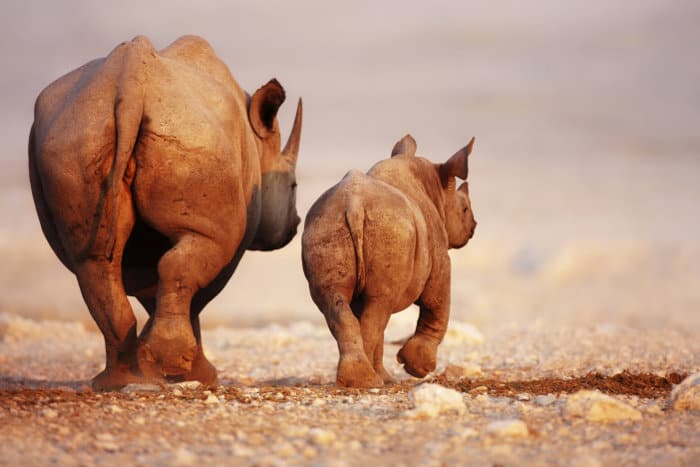
Although it sounds counter-intuitive, such an inhospitable environment makes the safari incredibly easy.
Life in the desert revolves around water. Animals must cluster close to where water remains. So every Namibia safari focuses on waterholes, pans or rivers. Find the water and you find the animals.
Vegetation is sparse. There are very few places for wildlife to hide. Again, this makes wildlife encounters easy. Just gaze across the desert and you can spot herds from miles away.
3. Living with giants
You must be tough to survive here. So step forward desert-adapted elephants, white rhinos, Angolan giraffe and some of Africa’s most elegant antelope species.
In terms of actual numbers there are less large mammals in Namibia than Botswana, South Africa, Kenya or Tanzania. However, as these animals gather in similar places it’s possible to experience a superb wildlife diversity in one place.
Most importantly, Namibia is where you get close. It’s where you feel the battle for survival and experience life on the edge. It’s one thing to see an elephant in a lush forest. It’s quite another to see the emotion on an elephant that has travelled five days to reach water.
Evocative scenes play out. Enchanting gestures communicate how these animals feel. There’s joy and energy. And then there is the brutal reality of life.
Perhaps a carcass being picked at by African vultures. Maybe a wounded animal stumbling away from a battle to mate; or lions tossing bones from a zebra carcass.
4. Africa’s cheapest safari
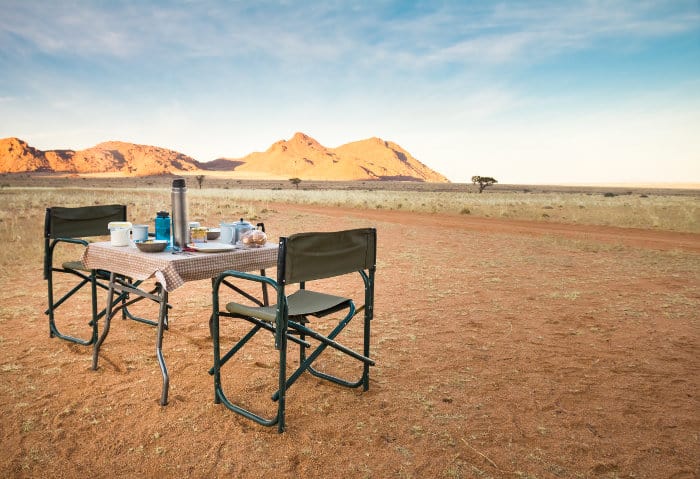
Probably the biggest reason for choosing a Namibia safari is the cost. Here you get the most intense encounters for the best price.
Park fees are lower than other Southern African countries and significantly less than in East Africa.
The camps and lodges are usually modest, without the thrills and luxuries of some in South Africa. Most of them are at the lower end of the price scale, which is very different from Botswana where camps could be USD 1000 per person a night.
Namibia’s public campsites are excellent. They are simple and well maintained, located in areas that can be rich in wildlife. Anyone who is self sufficient will find these camps accessible and cheap.
While Namibia is an enormous wilderness country the safari destinations are relatively easy to reach. A four-wheel drive vehicle is required.
But it’s not like in Botswana where flights are necessary to reach parts of the Okavango Delta, or in East Africa where it’s almost impossible to visit without a local tour.
Namibia is so vast that you don’t need to escape the crowds. You can have a private concession-style safari experience, full of exclusive natural encounters, without needing to pay a premium.
5. The best country for a self drive safari
Excellent camps, easy to find wildlife, and accessible destinations. That adds up to a great self drive destination. You do the safari and this is cheaper than a tour.
The classic way to explore Namibia is to rent a four-wheel drive vehicle that is equipped with a popup roof tent, a camp kitchen, and everything that’s needed for multiple days in the wild.
Visit the national parks, spend the days on safari, then set up at one of the campsites. It’s raw and rugged, an adventure in elephant country with no guides to protect you.
Self drive safaris are not advisable in East Africa – rules and regulations make them expensive and dangerous. One Africa Freak contributor encountered two backpackers in a Toyota hatchback stuck in the Serengeti mud, leaning out of the window taking photos of lions.
South Africa is good but doesn’t have the same wilderness factor, not when the Kruger now has a paved road through the middle of it.
Much of Botswana’s best safari destinations are inaccessible, either because the roads are washed away or the area has been gazetted as a private concession.
Then there is Namibia: freedom, beauty, safari and a connection with your wild side.
Guide to Namibia Safari Destinations
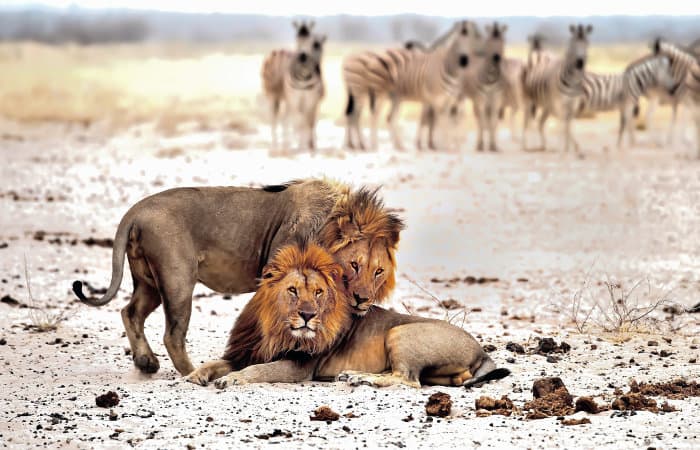
Etosha is one of Africa’s ultimate safari destinations. The rest in Namibia is good and exciting. Visit Namibia and Etosha has to be at the top of the list. If you can, add on the Caprivi Strip for an experience in contrasts.
Etosha National Park
Etosha has an eternal paradox. Like all of Namibia there is an incredible sense of wilderness and exploring a distant piece of old Africa. Yet Etosha is also very accessible and the game viewing is so simple.
There’s comfort and simplicity here, even when gazing across the shimmering Etosha salt pan. Within Etosha there’s the only water for hundreds of miles. That attracts a great succession of migratory mammals during the dry reason.
Often there’s a mystical collection of animals at a waterhole, a kind of animal party featuring hippos, gemsbok, impala, elephant, zebra and giraffe. Then the lions come and transform the dynamic.
The Etosha savannah is scorched yellow and red. Vegetation shrivels and a lot of the park appears lifeless. At the park’s heart is the Etosha Pan, a mammoth salt bed that the park is named after (Etosha literally means great white place).

Antelope splash about the pan after the rains. Elephants and buffalo dig for the nourishing salt. Gaze across the pan and rhinos emerge from the mirage, the image like something from a work of fiction.
After the pan shrivels and dries, life revolves around the park’s different waterholes. Most camps overlook one of these waterholes so a lot of the safari can be spent sat on a balcony, drinking a beer as wildlife also takes a drink.
The Etosha camp accommodation is very cheap in comparison to South Africa and Botswana, usually less than USD 150 per room for a very comfortable tented camp in a prime location (it may be USD 1000 in South Africa).
Public campsites aren’t next to the waterholes but are among migratory channels so you will see animals nearby. And every night the Etosha animals create their own noisy lullaby.
Animals to see and planning an Etosha visit
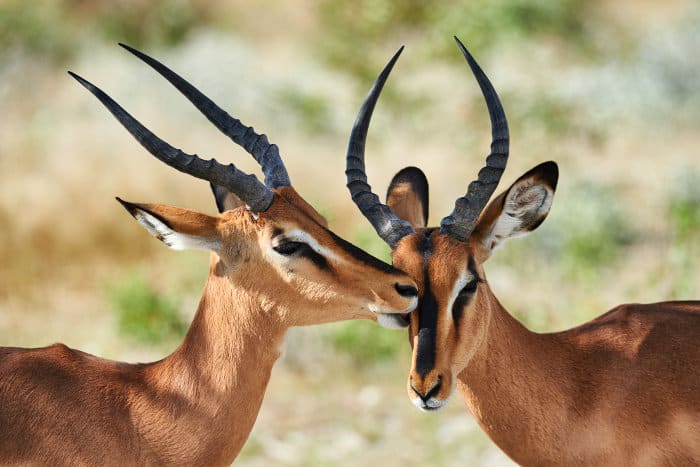
Etosha is home to four of the big five. It’s one of the best places in Africa to see white rhinos and their abundance is quite remarkable here.
Elusive species like black-faced impala are common. Tense predatory scenes are witnessed around the waterholes.
There’s just about everything you could ask for in a safari destination and the ease of the game viewing is elevated by Etosha’s openness. Spotting wildlife is straightforward, even without a guide.
Etosha is located in northern Namibia, roughly a four-hour drive from capital city Windhoek and seven hours from the Caprivi Strip.
Allow at least three full days. The park is big and there is more than enough wildlife for three days. Ideally consider four nights, allowing for two nights in two different sides of the park.
Ongava Game Reserve
A private concession in southern Etosha, Ongava is a luxurious and expensive destination. It’s typically included on high-end safari itineraries that use light aircraft to hop around the country.
The key highlight is the walking safaris, in particular walking safaris with white rhinos. Nighttime game drives and photography hides add to the intimacy.
Wildlife is similar to Etosha and there are only a dozen guests at a time, so it does feel very personal. Still, it’s debatable whether Ongava is worth the price when Etosha next door is so good.
Okonjima Nature Reserve
Halfway between Windhoek and Etosha, Okonjima can be a good Namibia safari introduction. The park is small and fenced but does provide good wildlife encounters, particularly with the cats.
Okonjima is home to the Africat Foundation that helps to rescue and rehabilitate Africa’s carnivores. These cats are in addition to free roaming wild predators. You will need to stay at the lodge in the reserve and one night is sufficient.
Caprivi Strip
Namibia’s fertile panhandle is a surreal contrast to the country’s desert wilderness. Forests and grasslands flourish as four of Africa’s great rivers take root: the Okavango, Zambezi, Chobe and Kwando.
These rivers attract migratory herds throughout the dry season, from various antelope to many thousands of elephant. Many animals stop by the Caprivi as part of their journey to the Okavango Delta or Chobe.
Animals and villages must coexist in the Caprivi. This makes sense: in a desert country almost everything wants to be near a river. There is no single national park but a series of small national parks interspersed with villages and a paved highway heading towards Victoria Falls.
Some of these have been established by local communities and the Caprivi Strip is a celebration of locally organised conservation.
Here there’s an acknowledgement that local people have been integral to conservation since the dawn of time. They’ve found a modern solution that satisfies the needs of wildlife, local people and tourists.
Bwabwata is the largest of the parks, followed by Mudumu and Nkasa Rupara. There’s also Caprivi Game Park, Mashi Conservancy, Wuparo Conservancy and Salambala Conservancy.
Although they don’t share borders, these parks do help create a single wilderness. They have successfully ensured the preservation of one of Africa’s most important wildlife corridors. Here you will see elephants and many other animals crossing the highway.
Each has either a public campsite or a camp and the prices are very reasonable.
Animals to see and planning a Caprivi visit

There is a little of everything but mostly you encounter elephants and different antelope. Giraffe poke their heads up above the trees, buffalo march around and zebra are conspicuous.
Don’t expect many big cat encounters. Not many live here and the lush vegetation makes them difficult to find.
Local San guides may be able to show you a wild dog den, so visitors with patience can be rewarded with sightings of one of Africa’s most endangered species; read the full wild dog story here.
It’s relatively easy to cover any of the parks in a single morning or afternoon drive. To spend more than two nights in any of these parks doesn’t make sense.
The Caprivi is in the far north of Namibia and it’s literally a 400 kilometre strip that juts above Botswana. Follow the strip to the end and you reach Victoria Falls.
We’d recommend spreading the Caprivi journey over three days. With that you can spend a night in two parks or conservancies before leaving Namibia to visit Victoria Falls or Chobe in Botswana.
But if you are blessed with time then extend the journey. These peaceful parks provide a beautiful connection with your wild side. No other people, a handful of grazing animals, and a fertile wilderness.
When to Go on a Namibia Safari

Namibia has clearly defined seasons and these have an enormous impact on the safari experience.
June to August – dry season, mild temperatures, good game viewing
- Mild days and cold nights; bring warm layers and expect to spend each evening around a campfire.
- Great dry season wildlife viewing with lots of animals around waterholes.
- Dusty skies which aren’t ideal for photography.
- Peak season can result in crowds, especially in parts of Etosha.
September to November – dry season, hot, excellent game viewing
- Hotter days and warmer nights; be prepared to sweat.
- Outstanding dry season game viewing; there is hardly any water left so wildlife is highly concentrated.
- Less visitors compared to June to August.
- The rains usually start in November and usually come as a relief.
December to January – wet season, very hot, best avoided
- Very hot days in the desert.
- Occasional storms but it doesn’t rain that much in the desert.
- A surprising number of visitors as it is school holiday time in Southern Africa.
- Animals have dispersed so game viewing is more difficult.
February to May – wet season, warm and beautiful
- Namibia is incredibly attractive after the rains have come.
- You may experience storms but mostly these months have blue skies and warm temperatures.
- Wildlife looks healthy and you can see lots of babies.
- However, it’s harder to see animals as they are dispersed.
Planning a Namibia Safari

Namibia safaris often require intensive planning as you must decide how to get around. Overland tours are the most popular mode of travel. You are in a small group and usually spend one to two weeks traveling through Namibia.
For self drive safaris think very carefully about where to pick up and return the vehicle. There’s a superb loop from Windhoek: Windhoek, Damaraland, Etosha, Caprivi Strip, Victoria Falls, then returning via Botswana.
It’s very tempting to extend the journey by starting in Cape Town or Johannesburg but this does add a lot of miles and fuel cost to an already long journey. However, coming from South Africa allows for a route incorporating Fish River Canyon and Sossusvlei.
Another option is to take public transport to Windhoek and then continue the journey from there. Windhoek based tour operators can take you on a three or four-day trip to Etosha for a reasonable price.
The more expensive option is a fly-in safari. Beautiful views extend from the window as you fly to Namibia’s distant destinations. These are aerial safaris and maximize the time you have, ideal if this is a multi-country and you only have two weeks in total.
Map of Namibia’s Main Parks
There’s at least a dozen national parks in Namibia. Here’s the country’s major protected areas and where to find them on a map.
Good Luck in Namibia

We love Namibia. This is where you really connect with your wild side.
At first it seems like an endless empty wilderness. Spend time and look closer, because this is where safari secrets hide.
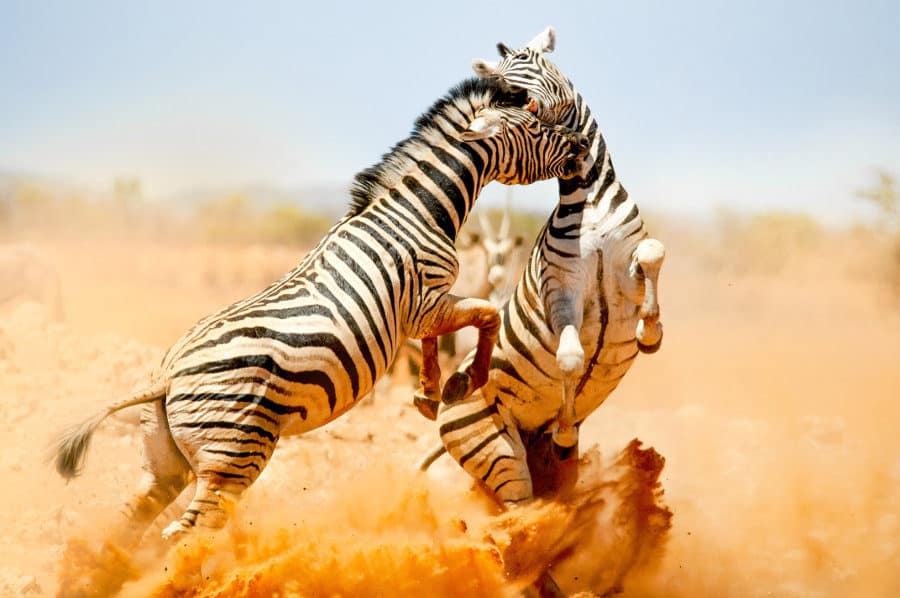
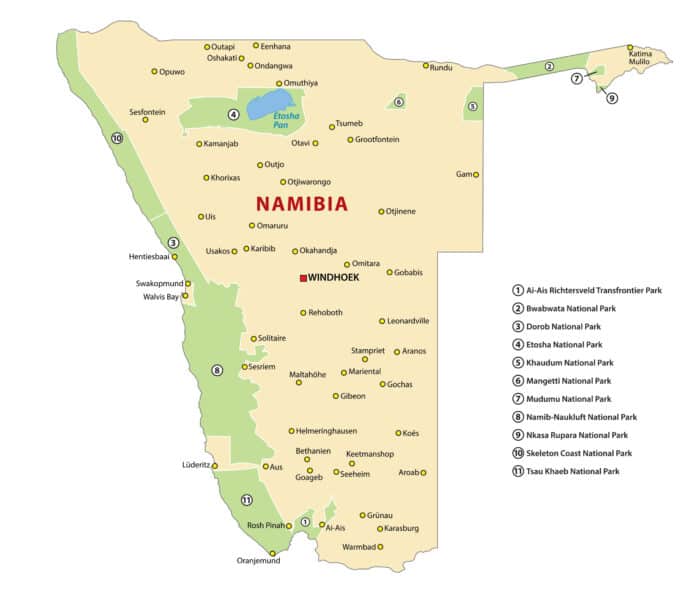

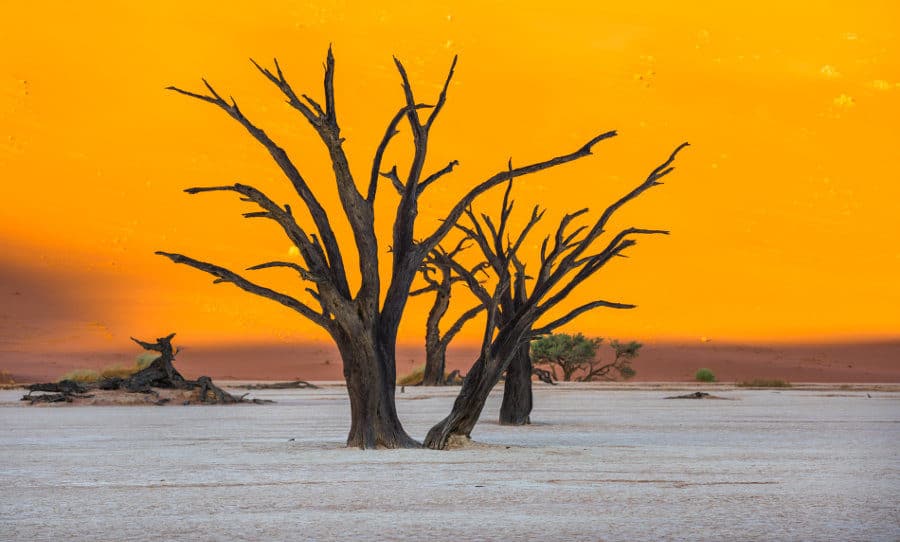

Hi,
Is it easy to arrive in the capital of Namibia and get a 5, 6 day tour/safari in a local enterprise, that will be cheaper then the ones we find on the internet and we contacted previously when abroad? I mean, I would like to know if I arrive in Namibia will it be easy to find a safari organized by locals, that are cheaper then the ones I find on the internet?
Thanks.
Hi Maria,
Sure, it is definitely possible to organize your trip once you land in Namibia. There are various travel operators, especially in Windhoek.
That being said, I wouldn’t say it is necessarily “easy”.
It still requires time to organize things properly. You need to find a reliable operator, you might not have as many options… plus pricing will depend on the travel period (more expensive in the high season; in July-October).
NB: Namibia is the perfect destination for self drive safaris, so this could be a nice option to consider if you prefer more flexibility and freedom.
Hopefully this helps.
Happy planning,
Michael